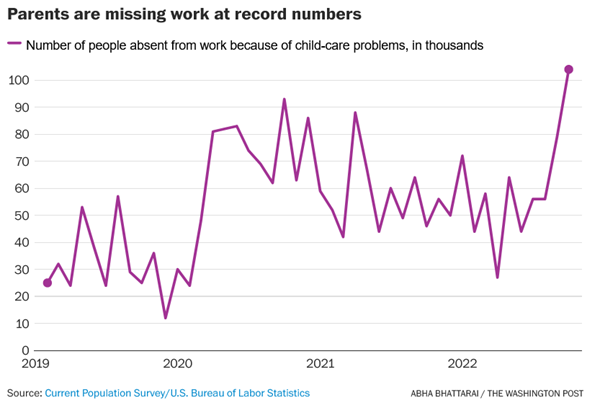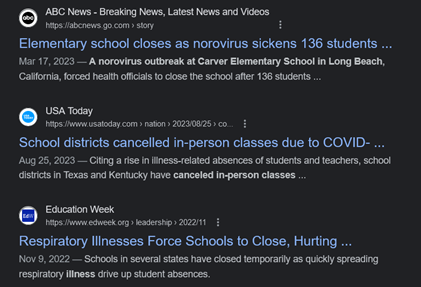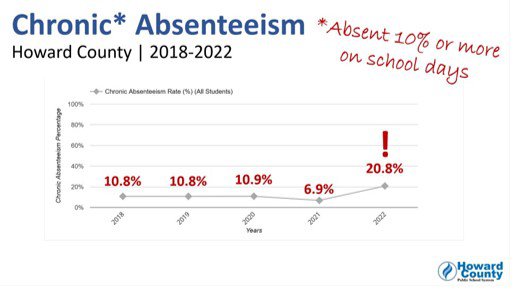Live in Baltimore on September 12, 2023, Dr. Michael Martirano, Superintendent of Howard County Public School System (HCPSS) in Maryland addressed the audience and Learning Counsel Media’s camera with a talk on absenteeism.
HCPSS has 57,325 students. 478 are homeless, 30.1% are students in poverty, 9.4% use Special Education Services, 5.9% are ESOL students.
While Dr. Martirano cited that research points to depression and anxiety disorders as major contributing factors of why students refuse to attend school. “Not only are these two indicators at the root of many absences, but the more time students spend outside of school, the more entrenched these feelings become and the harder it is to reverse course. Additionally, students are missing school for many other reasons – excused and unexcused – but the result is a greater likelihood of negatively impacting achievement,” said Dr. Martirano.
Nationally, the rate from the 2021-22 school year was 25% chronically absent -- a 91% increase from before the pandemic in the 2018-19 school year as reported by the State departments of education. In the 2022-22 school year this rate appears to be getting worse based on hundreds of conversations live in the field as Learning Counsel tours talking to school and district leaders. Only Highline Public Schools in the Seattle area with 18,000 students reported not having this issue, and the nationally renowned St. Vrain Valley Public Schools in the Denver area with 32,000 students.
Before sharing the rest of what Dr. Martirano shared as his top five successful actions to take, Learning Counsel looked into what else might be causing such high rates of absenteeism. This is what we found:
High Absences Are Everywhere – Not just Students
The Washington Post reported that there are continuing work absences by parents. Nearly three years into the pandemic, there is still pressure on health-care facilities, businesses and families. Workplaces have unfilled shifts and lost revenue as employees call out sick for extended periods of time. Parents are caught in an impossible situation since an estimated 63% are single parents. If the parent is sick, they might need older children to stay home to take care of those younger. If a child is sick, they need to stay home to care for them. If a school closes or has a health scare, there’s another time where absenteeism will be high.
“There are signs that those pressures are taking a toll on the economy. Worker productivity — a measure of goods and services an employee can produce in an hour — posted the sharpest plunge on record in the first half of this year, according to federal data.” In addition, there is a significant shortage of child-care workers. The U.S. Bureau of Labor Statistics reported that in 2023 the shortage is some 384,000. Nationally, the teacher shortage is much larger at nearly 1 million nationally. Adding that to the shortages in other sectors, and you get a picture of chaos still going on since the pandemic.

More Sicknesses, Lasting Longer
Several sources indicate that something is going on nationally with more sicknesses more often, especially with students which has never before happened in history.
Various views emerged from the research:
- Somehow the student body, and almost everyone everywhere is more severely sick more often.
- The student body had a couple of years of non-exposure and is going through a period of “catch-up” in exposure, so it will all pass eventually.
- Schools have altered policies about being slightly sick on campus.
You can use any search engine to find a lot of school closure stories indicating that either bullet point one or three is real in 2023:

It’s also happening globally.
One of many stories, the Bartko Global News reported on November 8th, 2022, that there were 14,000+ Edmonton students off sick as respiratory illnesses spike in region. 14,000!
“I’ve never seen this many viruses in children so frequently and so severe,” said Dr. Tehseen Ladha, who has worked in pediatrics for over a decade and said this is the worst season she’s seen — before and after the pandemic.
“All my clinics are children with respiratory viruses, with stomach flus, and many of them are children that have virus after virus. They’ve been sick since school has started.”
It’s also not just K-12 schools, but higher-ed as well. In another article on November 16, 2021, entitled Why is the student body so sick? Here’s what’s going around and how to stay safe, writer Sevana Wenn said, “Sit in any crowded lecture hall for more than a couple minutes and the cacophony of coughs and sneezes will compete with even the professor’s microphone. Why is the student body so sick, and what can be done about it?
According to Director of Student Health John Vaughn, the main culprit is non-COVID respiratory illness, particularly viral infections.
Hundreds of students have faced challenges in trying to manage the stresses of college life while being consistently under the weather. First-year Amy Fulton began feeling symptoms of respiratory illness ‘from the minute [she] stepped foot on campus.’ At times, these symptoms were so severe that Fulton sought medical attention from urgent care.”
As to the second point, it is obvious that when everyone was at home for a year to two full years, exposure to other viruses or just anxiety was lessened resulting in the potential when schools were bringing everyone together again there could be a surge of exposures.
However, any grade schoolteacher recalls the frequency of colds and flus but without the really high numbers of absences, and recovery times were the typical three days to a week. Yet schools operated differently then, allowing students to attend even if they had the sniffles.
In an article entitled “Why Did We Ever Send Sick Kids to School?” in The Atlantic, February 2021, the author Sarah Hosseini writes “Staying home to avoid catching and spreading the coronavirus during the pandemic, for all the fear and anxiety it has caused, has come with one unexpected benefit for my family: My kids haven’t been sick once, not even with the common cold. My husband and I noticed this with a sense of relief after months of virtual schooling. We’re extremely fortunate that none of us have caught the coronavirus, but on top of that, our days and weeks hadn’t been upended by multiple colds or the flu over the past year. No missed work. No hospital bills. No sleepless nights.
During my oldest daughter’s kindergarten and first-grade years, I sent her to school several times with a runny nose or a slight cough, just like the parents of many of her classmates did. She was permitted to attend school as long as she was fever-free without the use of any medicine for 24 hours.”
And therein lies a possible answer: new school policies which strongly discourage any illness on campus could be creating the spikes in absenteeism.
Hybrid & Online Flexibility Isn’t Going Away
Then there’s this third thing that is possibly causing a lot more of the absenteeism. Families learned to deal with virtual learning, hybrid learning where some time was virtual and some on-campus for folks like first-responder families, and others with fully online options with tutors and chat-bots during the pandemic. The pandemic did cause a whole lot of online shopping for alternatives because many schools struggled with doing virtual learning in a way that wasn’t just getting onto a video conference and trying to do the same sort of togetherness with the teacher central to the distribution of the knowledge verbally.
There is no going back from the errors and the perception by all of America that learning could be more flexible and that somehow it was boring and rather simplistic digital orchestration when in fact the outside world of digital learning apps was possibly far more in sync with the current generation’s norms of ingesting information and interacting with it. It also takes less time to complete highly crafted digital learning. That’s not to say families do not desire the human interactions and some aspects of human teaching, they now just think it should be purposeful, and that socialization should be purposeful and not just a casual after-effect of being together.
The evidence of this is the sharp increase in alternative schooling, the $9 Billion difference (Learning Counsel Research) in what consumers spend directly on all forms of digital learning versus all schools put together, and the rapid expansion of Choice laws allowing vouchers to walk out of traditional public schools in more and more States.
Higher Anxiety Could be a Generational Friction
Then there is the fact that the present Alpha Generation prefers a screen interface to humans. It’s the “channel” they are on. It’s not that they do not like humans, but the regimented scene of schools was created over two hundred years ago when most of the population was also used to sitting in church facing forward. This no longer holds true. The whole facing forward and whole-group orientation and manufacturing-line motion through spaces and time is alien to the majority of this generation. Schools are human-centric in their delivery and distribution of knowledge, also alien.
The alternate channel of the present generation, wherein they live in a virtual world and communicate fluently there and are not as much inculcated to the physical world, is unaccounted for by most traditional schools and most definitely causes added anxiety. It probably also increases the apparency of disciplinary issues. Like absenteeism.
Back to Dr. Martirano and HCPSS
Dr. Martirano said that his district’s “countywide attendance rate is 93.5% which is above the state average of 91.1%, but we see disparities in the overall attendance of students who are eligible for free and reduced meals (89.5%), live in foster care (87%), or are homeless (80.5%). Furthermore, we know that there are direct correlations between attendance and academic achievement. Research conducted by the Robert Wood Johnson Foundation led to many discoveries that are supported by our own data:
- Students who are chronically absent in preschool, kindergarten and first grade are much less likely to read at grade level by third grade—making them 4 times more likely to drop out of high school than proficient readers.
- A student who is chronically absent any year between grades 8 and 12 is more than 7 times more likely to drop out.”
“I am worried about a troubling trend of students who are not showing up to school. Too many students are not receiving the instruction, supports, guidance, and social interactions that are associated with school each day. The data we’re seeing in our schools shines a light on our attendance crisis:
Our chronic absenteeism rate jumped from 6.9% in 2021 to 20.8% in 2022. Our chronic absenteeism rate is similar to, though slightly higher, than the statewide number of 19.4%. To put this into perspective, 20.8% represents approximately 150 students in every school,” said Dr. Martirano.

Dr. Martirano’s Five Fixes:
- Engage students and parents. If there is one priority we need from our partnership with families, it’s to be sure their child is coming to school every day they are able. Of course, a healthy collaborative partnership requires effort from both sides, so it is imperative that we create cultures and learning environments where students know they are safe and connected to their peers and trusted adults. It is also vitally important that communication is occurring constantly between the school and family so there is a shared understanding of how many days of school a student is missing and the impact of those absences.
- Monitor Attendance Data and Practice. As detailed earlier, we are placing great importance on tracking attendance and the impacts that absenteeism has on academic achievement. But this is where I am calling on school administrators to join me. It is critically important that school administrators understand the data for the students in their schools. And not just overall data. We must prioritize putting names to the data and understanding the root causes of absenteeism for each student. Then, we must establish individualized plans for each student to help them overcome the reasons for missing school and be sure they are on track instructionally.
- Recognize Good and Improved Attendance. Through the use of positive recognition of students who are demonstrating good or improved attendance, we can reinforce and celebrate the behaviors we expect to see in students. Our focus must not be on perfect attendance because we don’t want to place expectations on students to attend school every day when they’re not feeling well or have other learning opportunities that may pull them out of school for a short amount of time. Consistent attendance should be the goal. Let’s also make efforts to recognize those who improve attendance from year to year or semester to semester to let them know we’re watching and noticing their effort. Not only will a simple reward such as verbal recognition, a certificate, or other effort help motivate students, it will entice those who may not be exhibiting consistent attendance to emulate the positive behaviors we are seeking of those who are receiving recognition.
- Provide Personalized Early Outreach. By the time a student is deemed to be chronically absent, they likely have a significant hill to climb to get back on track. We can’t wait that long to identify and support students who are missing school for any reason. The most effective way to reach students and families is through personal relationships. I continue to lift up the reality that to teach a child well you must know a child well. Who are the trusted adults in the school who know each of the students who are struggling to come to school? Who are their mentors? Who are the people who can get in touch either by phone call, personal conversation or even a home visit? That could be a school administrator, teacher or counselor – but it doesn’t have to be. It could be any adult in the school or associated with the school who has formed a bond with that particular student or their family. We can’t find ourselves in a situation where a student who is not attending school also doesn’t have an adult who is friendly and familiar to them.
- Develop Programmatic Response to Barriers. Our data paints a very clear picture of the groups of students who are at highest risk of being chronically absent. These are often the same groups who are disproportionate when we talk about academic achievement, mental health, discipline, and graduation rates. I am urging school-based and central leaders to dissect this data at each school to understand the student groups most at risk for absenteeism and imagine strategies to eliminate the barriers to them showing up. Solutions may include providing necessary mental health services, food, mentorship, tutoring, before and after school care, and other necessities. Once we clearly understand the problem and solution, we can seek the resources, partnerships and funding required to implement effective strategies for each school.
“The data is clear – student attendance has a direct correlation to academic achievement and future success. That is why it is critically important that we reverse the troubling trend in absenteeism today. This cannot wait and we cannot drag our feet. Beginning day one of this school year, I want school staff to begin contacting families of students who did not attend school on the first day or were tardy. We must begin to cultivate those relationships early and demonstrate that we care enough about their success to pick up the phone and call on day one,” said Dr. Martirano.
Thank you Dr. Martirano for your five points.
As a last idea on fixes, a company by the name of Identimetrics has a biometrics solution for attendance and many other transactions in schools for which there are no fingerprint images stored. Only encrypted numerical representations of the unique points of the fingerprint are stored. Great potentials for saving teacher time and spotting patterns, as well as creating efficiencies for other school transactions such as lunches and access to labs. Since the emphasis will be on human interactions of teachers acknowledging students to lower absences, the more important it will be to make attendance taking less onerous for teachers with heads-down typing in or making checkmarks on rosters.











